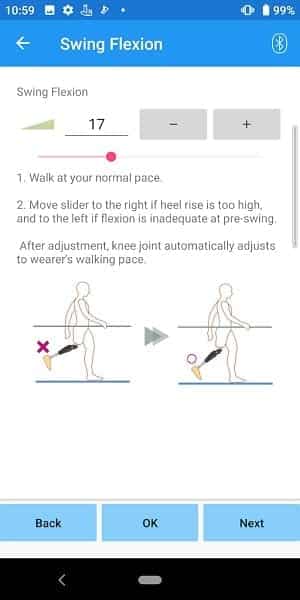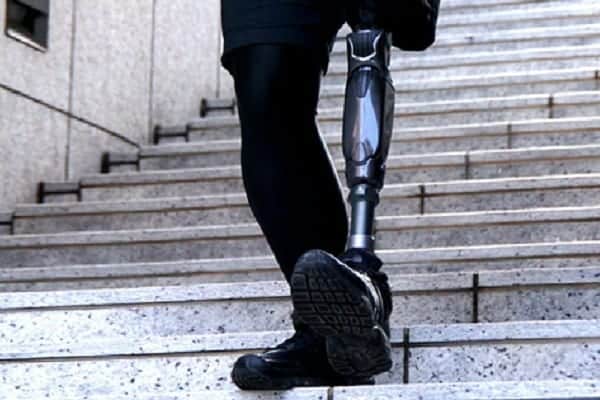Nabtesco’s Allux 2 Knee, distributed by Proteor USA, is a polycentric (4-bar) MPK that controls both the Stance and Swing phases.
What’s On This Page?
- A Quick Look at the Allux Knee
- Sensor & Microprocessor Capabilities
- 4-Bar Mechanical Design
- Compatibility with Prosthetic Feet
- Batteries
- Water & Dust Resistance
- Device Weight & User Weight Limit
- K-Level Rating
- User Software
- Warranty
- Price
- User Feedback Survey & Results
- Considerations Before Buying an Allux Knee
- Related Information
A Quick Look at the Allux Knee
Unfortunately, there are not many good videos of the Allux 2 in action. The following is the best video we could find because, starting at 3:33, it describes some of the main benefits of the Allux’s design:
We elaborate on these benefits in the sections below.
Allux Knee Key Features
Sensor & Microprocessor Capabilities
To understand how bionic knees work in general, please see A Complete Guide to Bionic Legs & Feet.
The short story is that the microprocessors in bionic knees typically have three main tasks:
- automatically adjusting the resistance in the knee to ensure the proper level of support through each stage of the Stance Phase regardless of terrain;
- ensuring the optimal release point for the knee to begin the Swing Phase and the proper knee extension/damping at the end of this phase;
- assisting in stumble recovery.
For the Stance Phase, the Allux Knee shares some similarities to bionic knees in the same price category, such as Ottobock’s C-Leg, Ossur’s Rheo, and Blatchford’s Orion. In brief, sensors help maintain awareness of:
- the angle and speed of knee movements;
- the nature of the current task, such as standing still.
The Allux’s stance-yielding function allows patients to easily walk down stairs and slopes step-over step.
Note, however, that the Allux is more dependent on the user to explicitly switch modes for activities such as cycling (it supports up to 5 programmable modes). It also relies more on the inherent advantages of its polycentric design for tasks like sitting or kneeling.
The Allux’s stumble recovery feature is similar to that of most bionic knees. When its microprocessor detects a stumble, the Allux immediately increases knee resistance (i.e. support) to aid in recovery and prevent a fall.
In the Swing Phase, the Allux actively manages similar issues to that other bionic knees:
- release of the knee at the optimal point to initiate the Swing Phase;
- the proper extension and terminal swing damping of the knee to support the transition from the Swing Phase back to the Stance Phase;
- management of heel rise during rapid acceleration.
It is, again, just more dependent on mode settings for these features. Note, also, that because the polycentric design shortens the length from the knee’s center to the toe during Swing Phase, it automatically provides more toe clearance, thus reducing the risk of tripping.
4-Bar Mechanical Design
Most bionic knees use a single-axis design, which is basically a simple hinge. The more this type of knee bends, the less stable it becomes.
The Allux Knee’s 4-bar linkage system allows the knee’s center of rotation to change as the knee bends, the same way that a natural knee works:

Source: Design and Characterization of a Novel Knee Articulation Mechanism – Scientific Figure on ResearchGate. Available from: https://www.researchgate.net/figure/The-left-knee-with-an-equivalent-crossed-four-bar-mechanism_fig2_308134411
This:
- improves stability;
- shortens the distance between the knee and the foot during the Swing Phase, as mentioned; this same shorter distance applies when sitting, which allows the knee height to be level with the natural knee of the other leg, if present;
- supports a greater range of motion, meaning that users can bend the knee more fully; for example, when tying shoelaces for the other foot.
Compatibility with Prosthetic Feet
The Allux Knee is compatible with any K3 foot on the market. Unlike many bionic knees, using a foot made by someone other than the knee manufacturer (in this case, Nabtesco) does not invalidate Allux’s warranty.
Batteries
The Allux Knee’s battery can last for up to four days depending on the level of activity. This is a significant advantage over most of its competitors.
If completely drained, the battery requires three hours to fully charge.
Water & Dust Resistance
The Allux Knee has an IP rating of 44, which means that it can be splashed by water from any angle. However, it should not be submerged in water. Nor should it be exposed to salt water or chlorine.
The knee is also protected against objects that are larger than 1 mm, but this does not mean that it is dustproof.
Device Weight & User Weight Limit
The Allux Knee weighs 1.5 kilograms. The maximum allowable user weight for the knee is 125 kilograms.
K-Level Rating
The Allux is rated for both K2 and K3 use. It is best suited for users who place a heavy emphasis on safety.
For a thorough understanding of K-levels, please see the Amputee Coalition’s web page on this topic.
User Software
The Allux Knee has five operational modes:
- Normal
- Flexion Angle Limit
- Variable Selection Flexion Lock
- Full Extension Lock
- Free Swing Mode
These operational modes can be customized by the prosthetist using Allux’s Adjustment App, which is also used to configure the knee:

Users can switch between the operational modes using Allux’s Remote Control App:

Both applications seem to have clean, comprehensive interfaces.
Warranty
The Allux comes with a three-year warranty that covers manufacturing defects. For this warranty to remain in effect, the knee must be serviced 24 months after purchase.
Users can also pay to extend the warranty to either five or six years. For the warranty to remain valid under these options, the knee must additionally be serviced 48 months after purchase.
We have not been able to find any documentation to verify that a free loaner knee will be provided during service inspections or repairs. However, we believe that this may have to do with the fact that the Allux Knee is manufactured by Nabtesco, which produces most of the documentation, but it is distributed in the U.S. by Proteor. It is best to check with your prosthetist on the loaner policy in your area.
Price
According to our information, the Allux Knee typically sells for between $30,000 and $40,000 US including the socket, prosthetic foot, and all prosthetist fees.
For a complete list of prices for other microprocessor knees, please see our Microprocessor Knee Price List.
User Feedback Survey & Results
Are you or have you previously been an Allux Knee customer? If so, please share your insights with others looking at the Allux as a possible prosthesis.
Survey
Results
We do not yet have a sufficient number of survey participants to publish fair and accurate results for the Allux Knee.
As soon as we do, we’ll update this section.
Considerations Before Buying an Allux Knee
While we don’t yet have a sufficient number of User Satisfaction Survey results to issue a formal report on the Allux, we can say that results to date have been mixed. The happier respondents so far have tended to be those with longer residual limbs, so this mixed result may well be an issue of compatibility. This suggests to us that most prospective patients should insist on a trial period to confirm whether the knee is right for them.
We’ve also had a couple of complaints about warranty support. Given that Proteor’s takeover of the Allux’s distribution in the United States by is relatively recent (2018), this is not surprising. Still, it is probably best to thoroughly explore this issue with your prosthetist before making a purchase.
Related Information
For a list of competitive devices, see Current Options for Microprocessor Knees.
For a comprehensive description of all current lower-limb technologies, devices, and research, see our complete guide.
Click here for more information on Allux’s distributor in the U.S, please see Proteor USA.
